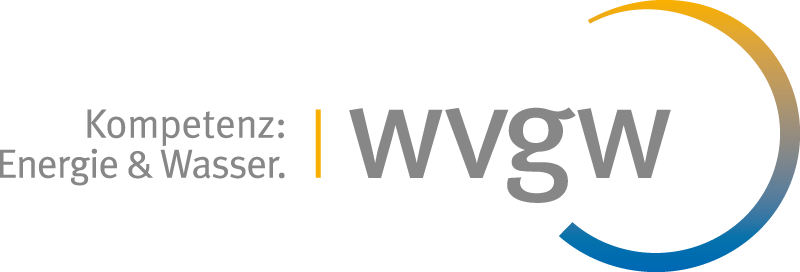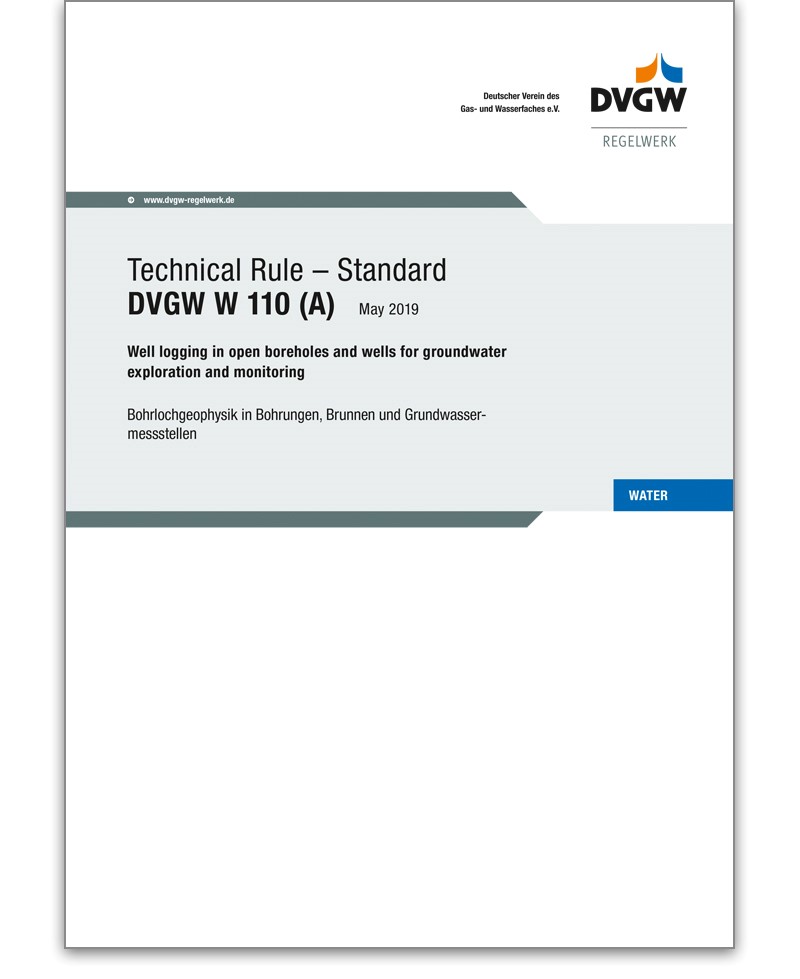W 110 Technical Rule - Standard 05/2019
Well logging in open boreholes and wells for groundwater exploration and monitoring ++ PDF file++
- Herausgeber/Verlag: DVGW
- Format: 36 pages
- Material: available as PDF only
- Ausgabe: 2019
- Hinweis: German version W 110
- Verkaufseinheit: 1
- Mindestabnahme: 1
- Artikel-Nr.: 510978
79,28 €*
This Standard W 110 intends to offer guidance for the beneficial use of geophysical logging measurements. It aims to help the user find the optimal combination of logging techniques for a defined task as early as in the concept phase of borehole surveys in vertical and, where due to design constraints, partially also in horizontal filter wells as well as in groundwater monitoring points. It is by no means a tool for evaluatingand interpreting geophysical measurements, a field that in the course of the last decade has evolved into an almost autonomous scientific discipline and, therefore, should be reserved for the relevant experts toengage in.This Standard applies to the design and execution of geophysical measurements in boreholes for groundwater exploration and abstraction in unconsolidated and consolidated rock, including well and groundwater monitoring point surveys. Drillings and probes used in near‑surface geothermal systems have a Special position in this context.
Foreword
1 Scope
2 Normative References
3 Terms, symbols, units and abbreviations
4 Introduction
5 Logging techniques
5.1 General
5.2 Nuclear logging techniques
5.2.1 General
5.2.2 Gamma-ray log (GR)
5.2.3 Spectral gamma-ray log (SGR)
5.2.4 Segmented gamma-ray log (SGRL
5.2.5 Gamma-gamma log (GG) and gamma-gamma density log (GG.D)
5.2.6 Rotating gamma-gamma density log (RGG.D)
5.2.7 Segmented gamma-gamma density log (SGG.D)
5.2.8 Neutron-neutron log (NN) and impulse neutron-neutron log (INN)
5.3 Electrical and electromagnetic logging techniques
5.3.1 General
5.3.2 Spontaneous potential log (SP
5.3.3 Electrical laterologs (EL, ML)
5.3.4 Focused electrical laterologs (FEL, DLL, MLL)
5.3.5 Dipmeter log (DIP)
5.3.6 Induction log (IL, DIL, FIL)
5.3.7 Magnetic susceptibility log (MAL)
5.3.8 Electro-magnetic defectoscope (EMDS)
5.4 Sonic logging techniques
5.4.1 General
5.4.2 Full waveform sonic (FWS)
5.4.3 Cement bond log (CBL)
5.4.4 Acoustic borehole imager (ABI)
5.4.5 Acoustic casing imager (ACI)
5.5 Optical logging techniques
5.5.1 General
5.5.2 Camera probe (TV)
5.5.3 Optical borehole imager (OBI)
5.5.4 Spectral adsorption coefficient (SAC)
5.6 Hydrodynamic logging techniques
5.6.1 General
5.6.2 Electrical conductivity (salinity)/temperature log (SAL/TEMP)
5.6.3 Milieu log (MIL)
5.6.4 Fluid density log (FDL)
5.6.5 Photometric turbidity measurement (PTM)
5.6.6 Impeller flow log (FLOW)
5.6.7 Tracer fluid log (TFL)
5.6.8 Flow direction measurement (FDM)
5.7 Other methods
5.7.1 General
5.7.2 Caliper log (CAL)
5.7.3 Borehole deviation log (BDL)
5.7.4 Packer flowmeter log (PFLOW)
5.7.5 Gas-dynamic test (GDT)
5.7.6 Temperature monitoring (TEMP.MON)
6 Quality assurance
7 Logging programmes
7.1 General
7.2 Logging programmes for open, temporarily cased/partially cased boreholes inunconsolidated rock
7.3 Logging programmes for open, temporarily cased/partially cased boreholes inconsolidated rock
7.4 Logging programmes for wells and groundwater monitoring points
8 Documentation and data structure
9 Guidance on tenders
9.1 General
9.2 Functional enquiries
9.3 Requesting concrete services
10 Legal aspects
10.1 Obligation of disclosure; duty to notify and to provide information
10.2 Licensing
Annex A (informative) ? Logging programmes for open, temporarily cased/partially casedboreholes in unconsolidated rock ? Recommended logging programmes
Annex B (informative) ? Logging programmes for open, temporarily cased/partially casedboreholes in consolidated rock ? Recommended logging programmes
Annex C (informative) ? Logging programmes for wells and groundwater monitoring points ?Recommended logging programmes
Annex D (informative) ? Service specification
Annex E (informative) ? Logging run terms
1 Scope
2 Normative References
3 Terms, symbols, units and abbreviations
4 Introduction
5 Logging techniques
5.1 General
5.2 Nuclear logging techniques
5.2.1 General
5.2.2 Gamma-ray log (GR)
5.2.3 Spectral gamma-ray log (SGR)
5.2.4 Segmented gamma-ray log (SGRL
5.2.5 Gamma-gamma log (GG) and gamma-gamma density log (GG.D)
5.2.6 Rotating gamma-gamma density log (RGG.D)
5.2.7 Segmented gamma-gamma density log (SGG.D)
5.2.8 Neutron-neutron log (NN) and impulse neutron-neutron log (INN)
5.3 Electrical and electromagnetic logging techniques
5.3.1 General
5.3.2 Spontaneous potential log (SP
5.3.3 Electrical laterologs (EL, ML)
5.3.4 Focused electrical laterologs (FEL, DLL, MLL)
5.3.5 Dipmeter log (DIP)
5.3.6 Induction log (IL, DIL, FIL)
5.3.7 Magnetic susceptibility log (MAL)
5.3.8 Electro-magnetic defectoscope (EMDS)
5.4 Sonic logging techniques
5.4.1 General
5.4.2 Full waveform sonic (FWS)
5.4.3 Cement bond log (CBL)
5.4.4 Acoustic borehole imager (ABI)
5.4.5 Acoustic casing imager (ACI)
5.5 Optical logging techniques
5.5.1 General
5.5.2 Camera probe (TV)
5.5.3 Optical borehole imager (OBI)
5.5.4 Spectral adsorption coefficient (SAC)
5.6 Hydrodynamic logging techniques
5.6.1 General
5.6.2 Electrical conductivity (salinity)/temperature log (SAL/TEMP)
5.6.3 Milieu log (MIL)
5.6.4 Fluid density log (FDL)
5.6.5 Photometric turbidity measurement (PTM)
5.6.6 Impeller flow log (FLOW)
5.6.7 Tracer fluid log (TFL)
5.6.8 Flow direction measurement (FDM)
5.7 Other methods
5.7.1 General
5.7.2 Caliper log (CAL)
5.7.3 Borehole deviation log (BDL)
5.7.4 Packer flowmeter log (PFLOW)
5.7.5 Gas-dynamic test (GDT)
5.7.6 Temperature monitoring (TEMP.MON)
6 Quality assurance
7 Logging programmes
7.1 General
7.2 Logging programmes for open, temporarily cased/partially cased boreholes inunconsolidated rock
7.3 Logging programmes for open, temporarily cased/partially cased boreholes inconsolidated rock
7.4 Logging programmes for wells and groundwater monitoring points
8 Documentation and data structure
9 Guidance on tenders
9.1 General
9.2 Functional enquiries
9.3 Requesting concrete services
10 Legal aspects
10.1 Obligation of disclosure; duty to notify and to provide information
10.2 Licensing
Annex A (informative) ? Logging programmes for open, temporarily cased/partially casedboreholes in unconsolidated rock ? Recommended logging programmes
Annex B (informative) ? Logging programmes for open, temporarily cased/partially casedboreholes in consolidated rock ? Recommended logging programmes
Annex C (informative) ? Logging programmes for wells and groundwater monitoring points ?Recommended logging programmes
Annex D (informative) ? Service specification
Annex E (informative) ? Logging run terms

